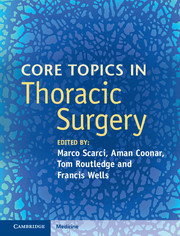Book contents
- Frontmatter
- Contents
- List of contributors
- Section I Diagnostic work-up of the thoracic surgery patient
- Section II Upper airway
- Section III Benign conditions of the lung
- Section IV Malignant conditions of the lung
- Section V Diseases of the pleura
- Section VI Diseases of the chest wall and diaphragm
- Section VII Disorders of the esophagus
- 23 Benign esophageal disease
- 24 Esophageal cancer
- 25 Esophageal perforation
- Section VIII Other topics
- Index
- References
23 - Benign esophageal disease
from Section VII - Disorders of the esophagus
Published online by Cambridge University Press: 05 September 2016
- Frontmatter
- Contents
- List of contributors
- Section I Diagnostic work-up of the thoracic surgery patient
- Section II Upper airway
- Section III Benign conditions of the lung
- Section IV Malignant conditions of the lung
- Section V Diseases of the pleura
- Section VI Diseases of the chest wall and diaphragm
- Section VII Disorders of the esophagus
- 23 Benign esophageal disease
- 24 Esophageal cancer
- 25 Esophageal perforation
- Section VIII Other topics
- Index
- References
Summary
Introduction
Benign esophageal disease is widely prevalent and often requires treatment, although the surgical management of the same is less commonly indicated. Surgical treatment of these diseases requires considerable expertise and is best left to those who manage these patients on a daily basis. However, a basic understanding of the diseases and their management is required by all cardiothoracic trainees and practicing thoracic surgeons, and this chapter is an attempt to enable them to do so.
Antireflux surgery
Gastroesophageal reflux disease (GERD) is a very common problem estimated to affect up to 35% of Americans; however, the true prevalence is unknown due to the widespread availability of over-the-counter medications that are able to lessen symptoms without any physician contact. Additionally, lack of consensus on the true constellation of symptoms that constitute the disease makes clinical diagnosis and therapeutic management a challenge. Typical GERD presents with classic symptoms of heartburn or acid regurgitation or both. A broad array of atypical symptoms can also be attributed to GERD, such as vomiting, dysphagia, chest pain, cough, asthma, sore throat, hoarseness, chronic aspiration, or idiopathic pneumonias.
Basic physiology
Heartburn is generally defined as substernal burning or discomfort that radiates upward from the epigastrium. Failure of the zone of high pressure located at the gastroesophageal (GE) junction is the most common etiology of GERD. This area, known as the lower esophageal sphincter (LES), is responsible for preventing retrograde flow of gastric material into the esophageal body. The LES is a region of thickening made up of the collar-sling musculature and clasp fibers of the upper stomach that remain in tonic opposition. Receptive relaxation triggered by the act of swallowing allows passage of a bolus into the stomach. The characteristics that maintain competency of the LES are its resting pressure, the overall length, and the intra-abdominal length subject to positive abdominal pressure. Physiologic or pathologic processes that affect these characteristics often result in GERD.
Median normal manometric values of the LES:
Pressure (mmHg): 13
Overall length (cm): 3.6
Abdominal length (cm): 2
Indications for surgery
A careful assessment of the patient's symptoms is essential before any therapeutic intervention should be undertaken. Many GERD-like symptoms may be associated with other disease processes and will not be relieved by operative intervention.
- Type
- Chapter
- Information
- Core Topics in Thoracic Surgery , pp. 221 - 233Publisher: Cambridge University PressPrint publication year: 2016



